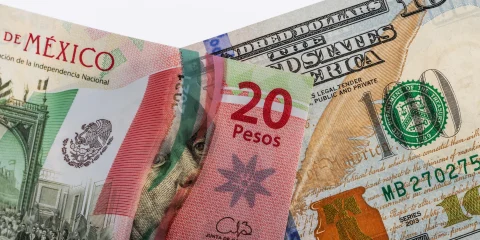How Much is a Dollar in Pesos?
By Cyndi Wright |

Savvy Traveler’s Guide: How Much is a Dollar in Pesos?
Are you planning to take a trip to sunny Mexico in the near future? If so, you may be wondering how much is a dollar in pesos? After all, you’ll want to be able to buy all the beautiful, handcrafted souvenirs, delicious food, and gas if you’ve decided to drive across the border.
Speaking of driving across the border: You need to purchase Mexican car insurance before you get to the border crossing of your choice — or very soon after. The thing is, buying ahead of time gives you the opportunity to buy the right coverage for your needs and avoid rushing to buy right before you cross, in particular if you are trying to cross in the early hours of the day.
Your US auto coverage policy will not cover you while you are driving in Mexico. It is, after all, a foreign country with different rules and regulations. Being caught driving there without the legal coverage can lead to problems you just don’t need, including having your vehicle impounded, fines and more. Your travel partner at Sanborn’s Mexico Car Insurance can help you get the legal vehicle coverage before you even leave your home. It’s available online and it’s cheap. Cross this important item off your list early so you can focus on deciding which type of sunscreen is perfect for swimming in the ocean and not harming the sea critters.
Now, let’s dive into how to turn your dollars into pesos.
Understanding the Mexico Exchange Rate
Here’s an exciting topic: exchange rates, yay! Many countries have their own type of currency, which makes buying things fun. You are probably most familiar with the US currency system of dollars and cents, also known worldwide as USD (United States dollar). In Mexico, the basic currency is the peso (MXN). An exchange rate is how much foreign currency you can purchase with your US currency.
Here’s some more fun news about the complicated topic of foreign money – the exchange rates can change every day (even every minute)! In Mexico, exchange rates are based on many different economic factors. Luckily, they typically don’t change by much. So, for example, your US dollar may be worth a little more than 16.33 pesos one day and 16.31 the next day. It’s not a huge change so it shouldn’t affect your ability to buy the sombrero of your choice. Here is some valuable information about currency exchange for Mexico (plus a handy exchange tool).
To put it all in perspective, one gallon of gasoline (3.78 liters in Mexico) will cost around 24.12 MXN (pesos) per liter, roughly equivalent to $5.57 USD. In order to be properly prepared when you drive toward your perfect beach vacation, take into account the size of your vehicle’s gas tank and how many miles you plan to drive. That way you’ll have the correct amount of pesos handy throughout your trip.
Most tourist spots and gasoline stations have the capacity to accept your USD and even your credit and debit cards. If you’d rather pay for your fuel in cash, take care to plan how much you’ll need for each leg.
Toll Road Tip for Driving in Mexico: It’s best to drive on the toll roads in Mexico wherever possible and avoid free roads. Toll roads only accept cash in pesos, so you’ll need to budget ahead for your drive. Use this tool to calculate your toll fees through your journey.
The Best Places to Exchange Your Money
Here’s a hint: It’s not in a dedicated “exchange shop” which tend to spring up wherever tourists gather, such as markets and bazaars. Almost all places charge a fee to exchange currency, so your mission is to find a place that charges a nominal, acceptable fee. Exchange shops charge a higher fee on average.
Here’s a tip for you frugal travelers — your own bank or credit union in America is probably the best place to exchange your money. Most banks and credit unions either exchange money for no fee or a nominal fee for their customers. You’ll save money if you arrive at a dollar amount you want to spend before you leave and get your pesos then.
If you find yourself short of pesos (and really, who doesn’t with all that amazing food and fun?), your best bet is to find an ATM (dónde está un cajero?) or go to a local bank. Depending on the ATM, you may be able to get pesos with your credit card. If offered the choice, choose to pay your transaction fees in pesos (it avoids a markup fee).
The Role of Mobile Apps in Currency Conversion
There are some apps (of course there are!) you can install on your mobile device to get the latest exchange rates and more. According to HelpLama’s 9 best currency exchange apps in 2024, two of the top ones include Xe Currency Converter, which received a 4.8 star rating from consumers and Currency Converter Plus, which stands at 4.7 stars. Famous world-traveler Rick Steves asked his followers what app they liked best and one commenter uses a free version of Xe Currency.
As with most apps, there are plenty of choices, so you can do some research on your own and pick one that works best for you. In addition to currency exchange apps, here are some essential apps for your road trip to Mexico.
Tips for Carrying and Exchanging Cash Safely
No matter where you travel in the world — even if it is two miles from home to the nearest ATM to get some bucks, there are common sense ways to make sure your hard-earned cash stays where it belongs, which is in your pocket not in the pocket of some opportunistic thief. So, let’s review a few tips on using an ATM or even taking cash from a bank or other exchange service.
- As in the US, you have the possibility of running into a skimmer anywhere you stick your card in a slot. A skimmer is a hidden card reader that steals your information. For this reason, it may be best to use an ATM inside a bank, if possible. If you are staying at a resort, you will have better luck using the ATM inside the resort, rather than out on the street.
- Be alert to who is around you when using an ATM. Don’t crowd someone using an ATM and don’t let someone crowd you while you are using the machine.
- Never flash cash. In fact, leave some of your cold, hard cash at the hotel safe and just carry what you need for the day’s fun. Or stash it in a few different, hard-to-find places in your vehicle, if you are not staying at a hotel or resort. Another good option is to carry your cash in an anti-theft purse.
Cultural Considerations and Tipping in Mexico
Tipping for good service is always welcome — anywhere you go. But questions still swirl around the practice. Should you tip in pesos or dollars? How much should you tip?
As in the US, tipping is considered a polite way to say thank you to someone who provides good service. Here are some common places and the normal tipping rates (it’s best to tip in cash and in pesos):
- Restaurants: 10-20%
- Street Food: It is not customary to tip, but there may be a tip jar. If so, toss in a few pesos for goodwill.
- Bartender (camarera/o): 10 to 20 pesos
- Taxi Drivers: Ask how much your ride will cost before you get in so you don’t have an overinflated bill at the end of the ride. Keep in mind that taxis are expensive and not normally tipped unless they handle luggage. However, if you feel like it, you can round up your bill so the driver keeps the change.
There are many service people you may interact with during your trip. As in the US, tipping is a nice way to say thank you and it helps supplement a wage.
Ready To Get A Quick Quote?

